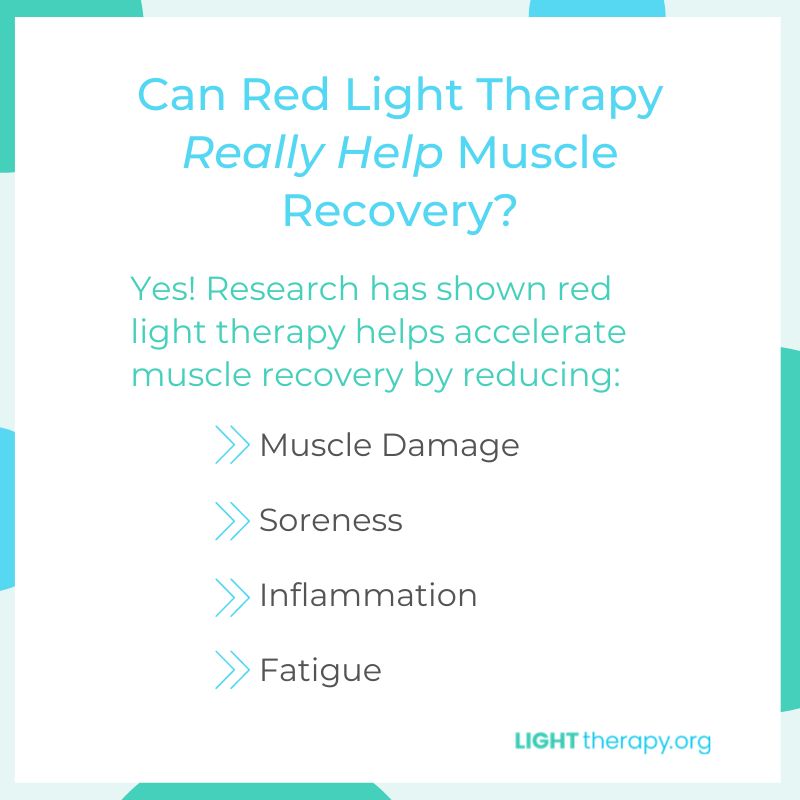How Red Light Therapy Can Accelerate Your Muscle Recovery
Light therapy has all sorts of applications for beauty, skincare, and other health concerns. But there’s another, lesser-known area of research on red light therapy: muscle recovery.
Does red light therapy help or hinder muscle recovery? When is it a good option? And how can you apply it in the most beneficial way?
How Does Muscle Recovery Work?
We all know exercise is beneficial. Working your heart and lungs keeps them healthy and strong. Strengthening your muscles keeps them from wasting away, stabilizes your body, and protects your joints. Stretching keeps you moving comfortably through life with minimal aches and pains.
But just as important as the exercise itself is what happens between exercise sessions. Microscopic tears form in your muscles when you challenge them during exercise, leading to soreness and the need for rest. The recovery process heals those muscles as you rest, increasing their mass and preparing them to be challenged again.
This is why personal trainers don’t recommend training the same muscle group two days in a row. Recovery between workout sessions is vital for building muscle.
Can Red Light Therapy Really Help Muscle Recovery?
Knowing that muscle recovery is important, athletes and performers have tried many methods to safely and effectively shorten the healing window — because the faster they recover, the faster they can get to their next workout.
Supplements, massage, cryotherapy — all have been tried with varying levels of success. But what about light therapy? Specifically, can red light therapy really accelerate muscle recovery?
According to research, the answer is yes.
For example, in 2016, researchers enrolled a set of identical twins in a study on the effects of light-emitting diode (LED) red light therapy and muscle recovery. Each twin completed a 12-week strength training program targeting their quadricep muscles. Three times per week directly after workouts, one twin received a red light therapy treatment and one received a placebo treatment.
The twin receiving red light therapy experienced reduced muscle damage, soreness, inflammation, and fatigue compared with his brother. He also saw greater increases in muscle mass and the load his muscles could bear.
These findings aren’t limited to one set of twins. A systematic review of multiple studies also concluded that red light therapy effectively improves muscle recovery.
One mechanism of red light therapy that may affect muscle recovery is its ability to increase blood circulation and oxygenation of tissues. This can contribute to quicker healing from muscle fatigue after workouts.
For example, one small study treated the forearms of healthy participants with red light for 10 minutes each. Researchers found that red light therapy significantly increased the blood flow, oxygen consumption, and oxygenation of the treated areas.
According to an article on red light therapy in Men’s Journal, the 2016 United States Olympic track team was convinced of red light’s benefits. They brought a $181,000 red light therapy pod with them to Rio to help them train harder and recover faster!

Should You Use Red Light Therapy Before or After Workouts?
If you’re interested in trying red light therapy for muscle recovery, should you use it before or after your workout? Is one more effective than the other?
Research actually supports both!
A large meta-analysis of 13 years of clinical studies showed that light therapy with red and infrared (IR) wavelengths administered before exercise improved muscle performance during the workout and accelerated muscle recovery after the workout.
However, the above study on twins also indicates benefit from red light therapy after exercise as well. Red light’s ability to stimulate quicker healing, reduce inflammation, and relieve pain still appears to benefit muscle recovery even if you have to save your light therapy session for after your workout.
Red Light Therapy for Injury Recovery
Recovery from the workout itself isn’t the only thing that keeps people from exercising as much as they’d like. Often, injury derails a workout plan and interferes with people’s favorite physical activities. Athletes in certain sports are prone to specific types of injuries as well.
Fortunately, the same mechanisms that make red light therapy useful for workout recovery mean it holds promise for injury recovery as well.
In one study, researchers treated 395 university athlete injuries with near-infrared light therapy over the course of 15 months. Injuries included contusions, sprains, strains, tendonitis, and damage to ligaments. The athletes received between two and six treatments of red light therapy, and researchers evaluated effectiveness based on reductions in pain and return-to-play time (compared to historically typical return-to-play time). On average, the return-to-play time of the athletes treated with red light therapy was half that of the historical norm.
In addition to treating sports injuries, red light therapy is also being researched as a possible treatment for back pain.
Talk With Your Doctor
With any serious injury, you should always check with your physician and get a medical diagnosis. You wouldn’t want to treat what you thought was a sprained ankle only to later find out you had a fracture! And if you decide to start red light therapy, be sure to let your doctor know so they can factor it into your overall care.